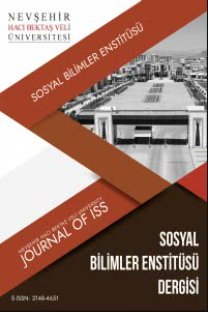TUNÇ ÇAĞI’NDA MEZOPOTAMYA VE MISIR İLİŞKİLERİ BAĞLAMINDA LAPİS LAZULİ
Mısır, Mezopotamya, Lapis Lazuli, Ticaret, Hediye
___
- Andrews, C. (1981). Catalogue of Egyptian Antiquities in the British Museum-Jewelry 1. London.
- Aston, B. (1994). Ancient Egyptian Stone Vessels. Materials and Forms. Heidelberg: Orientverlag.
- Aston, B, Harrell, J. ve Shaw I. (2000). “Stone”. P. T. Nicholson ve I. Shaw (Ed.) In Ancient Egyptian Materials and Technology (s. 5-77) içinde. Cambridge: Cambridge University Press.
- Bavay, L . (1997). “Matière Première et Commerce à Longue Distance: le Lapis-Lazuli et l”. Égypte Prédynastique. Archéo-Nil 7, 79-100.
- Bryan Cyril P. (1930). Ancient Egyptian Medicine the Papyrus Ebers. Chicago: Ares Publiserhs.
- Casanova, M. (2001). Le lapis-lazuli, la pierre précieuse de l’Orient ancien. Dialogues D’histoire Ancienne, 27 (2), 149-170
- Casanova, M. (2008). Lapis Lazuli. J. Aruz, K. Benzel ve M. Evans (Ed.). Beyond Babylon: Art, Trade and Diplomacy in the Second Millenium BC. (s. 68-70) içinde. New Haven and London: Yale University Press.
- Duffin C. J. (2014). The Pharmaceutical use of Lapis Lazuli in the Ancient East. British Society for the History of Pharmacy, 44 (4), 84-87.
- Eliade, M. (2020). Babil Simyası ve Kozmolojisi. Çev. M. Özcan. Doğubatı Yayınları: Ankara.
- Herrmann, G. (1968). Lapis Lazuli: The Early Phases of Its Trade. Iraq, XXX(1), 21-57.
- Huang, H. (2018). “The Route of Lapis Lazuli: Lapis Lazuli Trade From Afghanistan to Egypt During Mid-late Bronze Age”. 4th Annual International Conference on Modern Education and Social Science. Advances in Social Science, Education and Humanities Research (ASSEHR), V.183. 391-399.
- Law, R.W. (2014). Evaluating Potential Lapis lazuli Sources for Ancient South Asia Using Sulphure Isotope Analysis. C.C. Lamberg-Karlovski, B. Genito ve B. Cerasetti, (Ed.), “My life is like the Summer Rose”: Maurizio Tosi e l’Archeologia come modo di vivere. Papers in honour of Maurizio Tosi for his 70th birthday. Archaeopress (s. 419-429) içinde. Oxford: Archaeopress.
- Lo Giudice, A., Angelici, D., Re A., vd. (2017). “Protocol For Lapis Lazuli Provenance Determination: Evidence for an Afghan Origin of the Stones Used for Ancient Carved Artefacts Kept at the Egyptian Museum of Florence (Italy)”. Archaeol Anthropol Sci. 9, 637-651.
- Massa, M. ve Palmisano, A., (2018). Change and Continuity in the Long-distance Exchange Networks between Western/Central Anatolia, Northern Levant and Northern Mesopotamia, c.3200- 1600 BC. Journal of Anthropological Archaeology, 49, 65-87.
- Mclntosh J. R. (2008). The Ancient Indus Valley. California: ABC-CLIO.
- Moorey, P.R.S. (1994). Ancient Mesopotamian Materials and Industries: The Archaeological Evidence. Oxford: Clarendon Press.
- Moran, W. L. (1992). Amarna Letters, The Johns Hopkins University Press, Baltimore and London.
- Mynářová, J. (2012). “From the mountain or from the kiln? Lapis lazuli in the Amarna Letters”. G. del Olmo Lete, J. Vidal ve N. Wyatt (Ed.). The Perfumes of Seven Tamarisks Studies in Honour of Wilfred G. E. Watson (s. 63-69) içinde. Germany: Ugarit Verlag.
- Oshira, M. (2000). A Study of Lapis Lazuli in the Formative Period of Egyptian Culture: An Approach in Terms of Culture Contact. Orient, 35. 60-74.
- Payne, J. C.(1968). “Lapis Lazuli in Early Egpyt”. Iraq 30(1), 58-61.
- Peasnall, B. Ve Rothman M. S. (2002). One of Iraq’s Earliest Townns. Excavating Tepe GAwra in the Archives of the University of the Pennsylvania Museum 45 (3), 34-39.
- Pierrat-Bonnefois, G. (2008). The Tod Treasure. J. Aruz, K. Benzel ve M. Evans (Ed.). Beyond Babylon: Art, Trade and Diplomacy in the second Millenium BC. ( s. 65-67) içinde. New Haven and London: Yale University Press.
- Sarianidi, V.I. ve Kowalski, L.H. (1971). The Lapis Lazuli Route in the Ancient East. Archaeology 24 ( 1/1), 12-15.
- Sowada, K. N. (2009). Egypt in the Eastern Mediterranean during the Old Kingdom: An Archaeological Perspective. Fribourg, Switzerland / Göttingen, Germany: Academic Press / Vandenhoeck Ruprecht.
- Stevenson, A. (2003). “ Egypt and Mesopotamia”. H. Crawford (Ed.) in The Sümerian World (s. 620-636) içinde. London: Taylor & Francis Ltd.
- Thavapalan, S. (2019). The Meaning of Color in Ancient Mesopotamia. Culture and History of the Ancient Near East, 104. Leiden: Brill.
- Tosi, M. ve Vidale, M. (1990). 4th Millennium BC Lapis Lazuli Working at Mehrgarh, Pakistan. Paléorient 16, 89-99.
- Ward, W. A. (1964a). “Relations between Egypt and Mesopotamia from prehistoric times to the end of the Middle Kingdom(Concluded)”. Journal of the Economic and Social History of the Orient, 7 (2), 121-135.
- Ward, W. A. (1964b). “Relations between Egypt and Mesopotamia from prehistoric times to the end of the Middle Kingdom” Journal of the Economic and Social History of the Orient, 7 (1), 1-45.
- Winter, I. J. (1999). The Aesthetic Value of Lapis Lazuli in Mesopotamia. Cornaline et pierres précieuses. A. Caubet (Ed.). La Méditerranée de l’ Antiquité à l’ Islam (s. 43-58) içinde. Paris: Musée du Louvre.
- Yılmaz, C. (2020). Amarna Mektupları Işığında Akdeniz Dünyası’nın Siyasi ve Sosyal Görünümü. (Yayımlanmamış Doktora Tezi). Pamukkale Üniversitesi Sosyal Bilimler Enstitüsü, Denizli.
- Zöldföldi, J., Richter, S., Kasztovszky, Z. ve Mihali, J. (2006). Where does lapis lazuli come from? Non-destructive provenance analysis by PGAA, in: J. Pérez-Arantegui (Ed.), Proceedings of the 34th International Symposium on Archaeometry, Zaragoza 3-7 May 2004 (s. 353-36) içinde. Istitucion Fernando el Catolico, Zaragoza.
- İnternet Kaynakları https://www.metmuseum.org/erişim tarihi-10.10.2020
- https://egypt-museum.com/erişim tarihi-10.10.2020
- Yayın Aralığı: 4
- Başlangıç: 2011
- Yayıncı: Nevşehir Hacı Bektaş Veli Üniversitesi
TÜRKİYE’DE İLLERİN İDARİ KAPASİTE ENDEKSİ
BÜYÜK BRİTANYA'NIN İSTANBUL BÜYÜKELÇİSİ: JOHN MURRAY
TÜRK SİVİL HAVACILIK SEKTÖRÜNÜN EKONOMİK BÜYÜME ÜZERİNDEKİ ETKİSİ
POST-TRUTH VE DİJİTAL DİPLOMASİ
Şuay Nilhan AÇIKALIN, Esra SARI
NEVŞEHİR’DE GÜNÜMÜZE ULAŞAMAYAN BİR OSMANLI YAPISI: TAHTALI KAHVEHANE
KADINLARIN KARİYER YOLCULUKLARINDAKİ ENGELLERE METAFORİK BİR BAKIŞ
“FALA İNANMA FALSIZ KALMA” SÖZÜNÜN GÜCÜYLE DÖNÜŞEN/GENİŞLEYEN BAĞLAM: “KAHVE FALI” UYGULAMALARI
ARAP BAHARI SONRASI DÖNEMDE BÖLGESEL GÜVENLİK KOMPLEKSİ BAĞLAMINDA İRAN’IN LÜBNAN SİYASETİ
AKILLI ŞEHİRLERDE VATANDAŞ KATILIMI: SİSTEMATİK BİR LİTERATÜR ANALİZİ
ÖĞRETMEN ADAYLARININ COVİD-19 PANDEMİ KAVRAMINA İLİŞKİN ALGILARININ İNCELENMESİ
